Spectrum GU5.3 LED bulbs
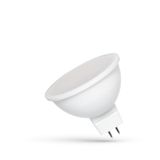

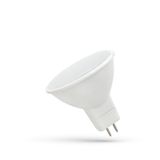





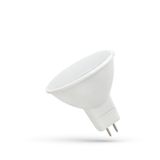
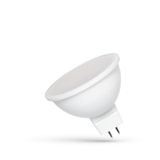
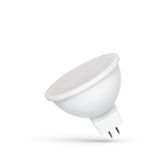
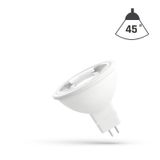
spectrum gu5.3 led bulbs range map and form factors
This family sticks to the classic MR16 footprint (Ø50 mm, length ≈45–52 mm) with G5.3 pins at 5.3 mm spacing, so trims, springs, and bezels from existing cans remain usable. Power nodes cluster at 4 W, 5.5 W, 6.5 W, and 7.5–8 W delivering roughly 320–700 lm depending on beam and CCT. Clear TIR optics serve accent beams; diffused lenses serve soft floods. Glass-and-reflector styles echo halogen looks; molded TIR heads maximize CBCP in retail and galleries.
spectrum mr16 led lamps optical packages and beams
Beam sets typically include 10° punch for showcases, 24°–36° for task cones over tables and counters, and 60° for general ambient. CBCP is the deciding number: a 6.5 W 10° can exceed 2 000 cd at 1 m, whereas a 36° at the same wattage sits lower but covers a wider task plane. Field-changeable honeycomb or softening films are offered on pro lines to tame near-field sparkle on glossy surfaces.
Electrical architecture and driver behaviour
All models are 12 V nominal, AC/DC compatible unless stated otherwise. Electronic-transformer compatibility is the make-or-break item: look for LED-rated ETs with a low minimum load or use a constant-voltage 12 V DC driver per circuit. Inrush is modest compared with halogen but parallel lamps on legacy ETs may still need a “minimum load” adapter. Dimming: trailing-edge (RC) channels are typically smoother; some SKUs accept leading-edge (RL). Expect stable 10–100% on flood beams and ~5–100% on narrow beams when channel load is adequate. Pro bins target PF ≥0.90, THD ≤15%, and flicker metrics around PstLM ≤ 1.0, SVM ≤ 0.4.
spectrum recessed lighting bulbs construction details
Housings use die-cast aluminum or thermally loaded polymer with internal heat pipes or slugs; Tc points are marked on the crown. Operating window is commonly −20…+40 °C with Tc ≤ 85 °C. Lenses are PMMA or tempered front glass with UV-stable seals. Dimensions honour MR16 trim depths; bezel diameters align to common 75–82 mm cutouts. IP20 is standard; IP44 lens fronts appear for bathrooms and wash areas when paired with rated cans.
Colour quality, CCTs, and lifetime
CCT options: 2700/3000/3500/4000 K; selected SKUs add 6500 K for inspection. CRI 80 covers circulation; CRI 90 with R9 > 50 is available for food, timber, fabrics, and skin tones. Source data comes from LM-80 packages with TM-21 projections; typical claims land at L70/L80 25–50k h at Ta 25 °C. SDCM ≤3 keeps colour drift invisible across rows; hospitality variants offer warm-dim engines that track halogen ambience.
Interfaces, safety, and standards you’ll actually use
- Safety/EMC: EN/IEC 62031 (LED modules), EN 61347-2-13 and IEC 62384 (control gear inside the lamp), EN 62560 marking for retrofit lamps, EN 55015/EN 61547 EMC, EN 61000-3-2/-3-3 mains quality.
- Photobiological: EN 62471 RG0/RG1 classes on typical outputs.
- Fitment: IEC 60061 GZ/GU profiles; these are GU5.3 two-pin types—verify holder temperature class (T-rating) in insulated cans.
Series and sub-collections at a glance
- Accent TIR: tight 10°/24° beams, highest CBCP, CRI 90 focus, matte black or white crowns to hide glare.
- General flood: 36°/60° optics, best lm/W, CRI 80 or 90, quieter thermal profile for shallow cans.
- Warm-dim: 3000 → ~1800 K curve on dim, hospitality glass looks, lower peak lm.
- IP44 front: sealed lens ring for bathrooms and wash zones using compatible downlight cans.
Copatibility notes and common pitfalls
Legacy magnetic transformers tolerate small loads but can buzz on phase-cut; modern electronic transformers need LED-rated minimum load and often trailing-edge control. Keep secondary leads short to reduce voltage drop; long twin-lead runs can shave low-end dimming headroom. In tight cavities, avoid felt insulation touching the crown—elevated Tc shortens life and shifts colour on CRI 90 lamps.
Use cases and optic selection
Retail highlights and vitrines: 10°–24° CRI 90, 3000–3500 K, anti-glare accessories. Hospitality tables and corridors: 24°–36° at 2700–3000 K with warm-dim where ambience matters. Worktops and displays: 36°–60° at 3000/4000 K, CRI 90 for colour-critical tasks. For shallow heritage trims, choose short-neck bodies with diffused lenses to hide LED structure in direct view.
spectrum directional spot lamps integration with the catalog
These heads drop straight into Spectrum’s fixed and tilt MR16 gimbals, and they share finishes with pendant roses and accessory bezels. Where pendant accents or linears are planned nearby, match the CCT/CRI policy so merchandise doesn’t shift colour across zones. Emergency is luminaire-dependent—if EM is required, use compatible downlight bodies with maintained kits rather than relying on lamp-only behaviour.
Selection guide for planners and buyers
- Beam and CBCP at working distance, then wattage.
- CCT/CRI to the task; CRI 90 for materials and food, CRI 80 for circulation.
- Driver path: LED-rated electronic transformer vs 12 V DC driver; declare dimmer type early.
- Thermal headroom: recessed can volume, insulation clearances, holder T-class.
- Ingress: front IP where bathrooms or wash-adjacent zones exist.
Documentation: ask for LM-80/TM-21, PstLM/SVM, and transformer compatibility tables with the submittal.